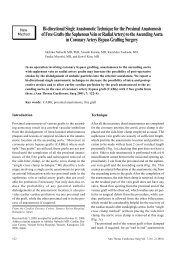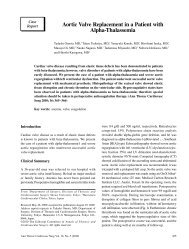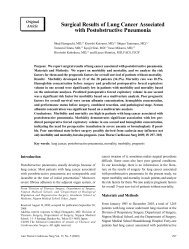Epidermal Growth Factor Receptor Gene Mutations in Early ... - Atcs.jp
Epidermal Growth Factor Receptor Gene Mutations in Early ... - Atcs.jp
Epidermal Growth Factor Receptor Gene Mutations in Early ... - Atcs.jp
You also want an ePaper? Increase the reach of your titles
YUMPU automatically turns print PDFs into web optimized ePapers that Google loves.
Orig<strong>in</strong>al<br />
Article<br />
<strong>Epidermal</strong> <strong>Growth</strong> <strong>Factor</strong> <strong>Receptor</strong> <strong>Gene</strong> <strong>Mutations</strong><br />
<strong>in</strong> <strong>Early</strong> Pulmonary Adenocarc<strong>in</strong>omas<br />
Haruhiko Nakamura, MD, PhD, 1 Norihito Kawasaki, MD, 1 Masahiko Taguchi, MD, PhD, 1<br />
and Harubumi Kato, MD, PhD 2<br />
Background: <strong>Epidermal</strong> growth factor receptor (EGFR) gene mutations are frequently found<br />
<strong>in</strong> pulmonary adenocarc<strong>in</strong>omas.<br />
Materials and Methods: Various lung cancers (n=30) <strong>in</strong>clud<strong>in</strong>g 8 small adenocarc<strong>in</strong>omas were<br />
exam<strong>in</strong>ed for EGFR gene mutations <strong>in</strong> three exons.<br />
Results: <strong>Mutations</strong> were detected <strong>in</strong> 32% of adenocarc<strong>in</strong>omas. Exon 19 mutations were detected<br />
<strong>in</strong> 5 tumors, often advanced stages: 1 <strong>in</strong> Noguchi’s pathologic type C, 2 <strong>in</strong> type D, and 2 <strong>in</strong><br />
type F. Exon 21 mutations were detected <strong>in</strong> 3 tumors, all small adenocarc<strong>in</strong>omas <strong>in</strong> type C, at<br />
pathologic stage IA.<br />
Conclusion: We suspect that exon 21 mutations are early events <strong>in</strong> small bronchioloalveolar<br />
carc<strong>in</strong>omas, while exon 19 mutations are later events occurr<strong>in</strong>g <strong>in</strong> adenocarc<strong>in</strong>omas of various<br />
types. (Ann Thorac Cardiovasc Surg 2007; 13: 87–92)<br />
Key words: epidermal growth factor, lung cancer, adenocarc<strong>in</strong>oma, mutation, bronchioloalveolar<br />
carc<strong>in</strong>oma<br />
Introduction<br />
Lung cancer is the lead<strong>in</strong>g cause of cancer death worldwide<br />
1) ; despite much effort to conquer this disease, the<br />
overall survival rate is approximately 10%. Recently, molecular<br />
therapy target<strong>in</strong>g the epidermal growth factor receptor<br />
(EGFR) has become the second- or third-l<strong>in</strong>e treatment<br />
for selected patients with non-small-cell lung cancer<br />
(NSCLC). 2,3) Tyros<strong>in</strong>e k<strong>in</strong>ase <strong>in</strong>hibitors such as<br />
gefit<strong>in</strong>ib 4,5) and erlot<strong>in</strong>ib, 6) were developed to <strong>in</strong>hibit signal<br />
transduction pathways mediated by the EGFR, thus<br />
selectively suppress<strong>in</strong>g proliferation of lung cancer cells<br />
that carry activat<strong>in</strong>g mutations of the region encod<strong>in</strong>g the<br />
cleft with<strong>in</strong> the EGFR prote<strong>in</strong> that b<strong>in</strong>ds adenos<strong>in</strong>e triphosphate<br />
(ATP). 7,8) The mutations detected were s<strong>in</strong>gle-base<br />
From 1 Department of Chest Surgery, Atami Hospital International<br />
University of Health and Welfare, Atami, and 2 Department of Surgery,<br />
Tokyo Medical University Hospital, Tokyo, Japan<br />
Received June 19, 2006; accepted for publication August 16, 2006.<br />
Address repr<strong>in</strong>t requests to Haruhiko Nakamura MD, PhD:<br />
Department of Chest Surgery, Atami Hospital International<br />
University of Health and Welfare, 13–1 Higashikaigan-cho, Atami,<br />
Shizuoka 413–0012, Japan.<br />
substitutions or small <strong>in</strong>-frame deletions occurr<strong>in</strong>g <strong>in</strong> the<br />
known “hot spot” for mutation, exons 18, 19 and 21. Importantly,<br />
these mutations were detected selectively <strong>in</strong><br />
tumors respond<strong>in</strong>g to gefit<strong>in</strong>ib or erlot<strong>in</strong>ib, 7,8) which frequently<br />
were adenocarc<strong>in</strong>omas <strong>in</strong> women who never<br />
smoked. As these activat<strong>in</strong>g mutations are more frequent<br />
tumors <strong>in</strong> Asians than Westerners, the significantly higher<br />
response rates to gefit<strong>in</strong>ib <strong>in</strong> Japanese reported <strong>in</strong> multi<strong>in</strong>stitutional<br />
cl<strong>in</strong>ical trials 2) were attributed to high prevalence<br />
of EGFR gene mutations <strong>in</strong> this population.<br />
While an association between gefit<strong>in</strong>ib responsiveness<br />
and EGFR mutations has been demonstrated, when EGFR<br />
mutations occur dur<strong>in</strong>g carc<strong>in</strong>ogenesis <strong>in</strong> the lung still is<br />
unclear. Noguchi et al. 9) classified small peripheral adenocarc<strong>in</strong>omas<br />
<strong>in</strong>to six types based on tumor growth patterns;<br />
types A and B represented <strong>in</strong> situ peripheral<br />
bronchioloalveolar carc<strong>in</strong>omas that did not <strong>in</strong>volve lymph<br />
nodes 10) and required computed tomography (CT) for<br />
detection. Type C appears to be advanced slightly beyond<br />
types A and B, show<strong>in</strong>g active fibroblastic proliferation.<br />
On the other hand, types D (poorly differentiated adenocarc<strong>in</strong>oma),<br />
E (tubular adenocarc<strong>in</strong>oma), and F (papillary<br />
adenocarc<strong>in</strong>oma with compressive and destructive<br />
Ann Thorac Cardiovasc Surg Vol. 13, No. 2 (2007)<br />
87
Nakamura et al.<br />
AB<br />
Fig. 1. Results of s<strong>in</strong>gle-strand conformation polymorphism<br />
(SSCP) analysis.<br />
The DNA strand with the mutation shows a mobility shift on a<br />
gel.<br />
A: SSCP analysis of exon 19 carried out at 10˚C for 4 h. Mobility<br />
shift is observed <strong>in</strong> cases 2, 6, 12, 25, and 26.<br />
B: SSCP analysis of exon 21 carried out at 10˚C for 4 h. Mobility<br />
shift is observed <strong>in</strong> cases 1, 7, and 11. All of these<br />
abnormal DNA strands were sequenced to identify the altered<br />
bases.<br />
growth) are regarded as more aggressive cancers. This<br />
classification is widely considered to accurately depict<br />
the diverse array of pulmonary adenocarc<strong>in</strong>omas. We<br />
therefore sought to clarify when EGFR mutation occurred<br />
dur<strong>in</strong>g development of small pulmonary adenocarc<strong>in</strong>omas,<br />
us<strong>in</strong>g the Noguchi’s classification to estimate relative<br />
time po<strong>in</strong>ts <strong>in</strong> tumor development.<br />
Materials and Methods<br />
Patient characteristics<br />
Resected lung cancer tissues from 30 patients who underwent<br />
lobectomy and systematic lymph node dissection<br />
<strong>in</strong> Tokyo Medical University Hospital were studied<br />
with respect to EGFR gene mutations. Histologic types<br />
<strong>in</strong>cluded 25 adenocarc<strong>in</strong>omas and 5 other carc<strong>in</strong>omas<br />
<strong>in</strong>clud<strong>in</strong>g 2 squamous cell carc<strong>in</strong>omas, 2 large cell carc<strong>in</strong>omas,<br />
and 1 small cell carc<strong>in</strong>oma. Noguchi’s pathologic<br />
classification was applied to all adenocarc<strong>in</strong>omas,<br />
<strong>in</strong>clud<strong>in</strong>g some tumors larger than 20 mm. Adenocarc<strong>in</strong>omas<br />
<strong>in</strong>cluded 2 <strong>in</strong> type A, 1 <strong>in</strong> type B, 7 <strong>in</strong> type C, 10 <strong>in</strong><br />
type D, 2 <strong>in</strong> type E, and 3 <strong>in</strong> type F. Pathologic (p-) stages<br />
of the 30 carc<strong>in</strong>omas accord<strong>in</strong>g to <strong>in</strong>ternational stag<strong>in</strong>g<br />
criteria 11) were IA <strong>in</strong> 15, IB <strong>in</strong> 5, and IIA to IIIB <strong>in</strong> 10.<br />
The p-IA tumors <strong>in</strong>cluded 8 small adenocarc<strong>in</strong>omas with<br />
a largest dimension below 20 mm. Written <strong>in</strong>formed consent<br />
for genetic analysis of the resected tumor was obta<strong>in</strong>ed<br />
from all patients. In the operat<strong>in</strong>g room, immediately<br />
upon resection of a pulmonary lobe conta<strong>in</strong><strong>in</strong>g a<br />
primary lung cancer, about 500-mg sample was removed<br />
from the tumor, immersed <strong>in</strong> liquid nitrogen, and stored<br />
at −80˚C until genetic study.<br />
Detection of the EGFR gene mutation<br />
Genomic DNA was extracted from the stored tumor us<strong>in</strong>g<br />
a REDExtract -N-Amp Tissue PCR kit (Sigma, St.<br />
Louis, MO). The three exons <strong>in</strong> the EGFR gene (exons<br />
18, 19, and 21) reported to <strong>in</strong>clude frequent mutation sites<br />
were amplified by polymerase cha<strong>in</strong> reaction (PCR).<br />
Primer sequences of 5´-AGGTGACCCTTGTC-<br />
TCTGTGTTCT-3´ and 5´-CACCAGACCATGA-<br />
GAGGCCCTGCG-3´ were used to amplify 216 base pairs<br />
<strong>in</strong> exon 18 by two-step PCR at an anneal<strong>in</strong>g temperature<br />
of 68˚C; 5´-GATCACTGGGCAGCATGTGGCACC-3´<br />
and 5´-TGGACCCCCACACAGCAAAGCAGA-3´ to<br />
amplify 199 base pairs <strong>in</strong> exon 19 by two-step PCR at<br />
anneal<strong>in</strong>g temperature of 68˚C; and 5´-TTCCC-<br />
ATGATGATCTGTC-3´ and 5´-ATGCTGGCTGA-<br />
CCTAAA-3´ to amplify 232 base pairs <strong>in</strong> exon 21 by<br />
three-step PCR at an anneal<strong>in</strong>g temperature of 55˚C.<br />
Amplified sequences with<strong>in</strong> each exon <strong>in</strong>itially were<br />
screened for mutations by s<strong>in</strong>gle-strand conformation<br />
polymorphism (SSCP) analysis us<strong>in</strong>g 14% polyacrylamide<br />
gels. Samples were electrophoresed at 72 V/cm<br />
under two different conditions, 10˚C for 4 h and 20˚C for<br />
2 h. Isolated DNA strands show<strong>in</strong>g a mobility shift on<br />
gels were cut from gels, and these isolated DNA strands<br />
were sequenced us<strong>in</strong>g cycle sequenc<strong>in</strong>g kit (BigDye Term<strong>in</strong>ator<br />
version 3.1, Applied Biosystems, Foster City, CA)<br />
<strong>in</strong> a DNA analyzer (Applied Biosystems 3730x).<br />
Statistical analysis<br />
Differences <strong>in</strong> distribution of EGFR mutations between<br />
two groups were tested by Fisher’s exact probability test.<br />
88<br />
Ann Thorac Cardiovasc Surg Vol. 13, No. 2 (2007)
Case<br />
Age Gender Smok<strong>in</strong>g status (SI)<br />
Pathologic Noguchi’s<br />
type classification<br />
<strong>Epidermal</strong> <strong>Growth</strong> <strong>Factor</strong> <strong>Receptor</strong> <strong>Gene</strong> <strong>Mutations</strong> <strong>in</strong> <strong>Early</strong> Pulmonary Adenocarc<strong>in</strong>omas<br />
Table 1. Results of the EGFR mutation analysis<br />
EGFR mutation<br />
Largest<br />
dimension<br />
Pathologic<br />
stage (mm) v ly<br />
analysis<br />
(exons 18, 19,<br />
Changes <strong>in</strong><br />
am<strong>in</strong>o acids<br />
and 21)<br />
1 71 F Never smoked W/D Ad C 25 T1N0M0 IA – – exon 21 T2573 G L858 R<br />
2 81 F Never smoked W/D Ad F 25 T1N0M0 IA – – exon 19 2235–2249 E746–A750 del<br />
del (15 base)<br />
3 77 M Current smoker (1,000) P/D Ad D 31 T2M0N0 IB 2+ – Normal Normal<br />
4 69 F Current smoker (450) W/D Ad B 10 T1N0M0 IA – – Normal Normal<br />
5 68 F Never smoked P/D Ad D 25 T1N2M0 IIIA 1+ 1+ Normal Normal<br />
6 71 M Never smoked P/D Ad D 60 T2N1M0 IIB 2+ 1+ exon 19 2239–2251 L747–T751<br />
del (13 base), <strong>in</strong>s C del, <strong>in</strong>s P<br />
7 70 F Never smoked W/D Ad C 15 T1N0M0 IA – 1+ exon 21 T2573 G L858 R<br />
8 65 M Never smoked La NA 70 T2M0N0 IB 2+ 1+ Normal Normal<br />
9 65 M Current smoker (1,140) P/D Ad D 15 T4N1M0 IIIB 2+ 1+ Normal Normal<br />
10 55 M Current smoker (2,960) M/D Ad F 25 T1N0M0 IA 2+ – Normal Normal<br />
11 69 M Current smoker (400) W/D Ad C 28 T1N0M0 IA – – exon 21 T2573 G L858 R<br />
12 71 F Never smoked W/D Ad F 20 T1N1M0 IIA – – exon 19 2235–2249 E746–A750 del<br />
del (15 base)<br />
13 55 M Current smoker (760) P/D Ad D 50 T2M0N0 IB – – Normal Normal<br />
14 54 F Never smoked W/D Ad A 10 T1N0M0 IA – – Normal Normal<br />
15 72 F Current smoker (1,060) M/D Sq NA 60 T2N1M0 IIB – – Normal Normal<br />
16 76 M Current smoker (340) W/D Ad E 60 T4N0M0 IIIB – – Normal Normal<br />
17 74 M Current smoker (1,650) P/D Ad D 20 T1N0M0 IA 1+ – Normal Normal<br />
18 66 M Current smoker (920) M/D Sq NA 37 T2M0N0 IB – – Normal Normal<br />
19 71 F Never smoked La NA 22 T4N0M0 IIIB – – Normal Normal<br />
20 77 M Current smoker (1,140) Sm NA 34 T2M0N0 IB 2+ – Normal Normal<br />
21 64 M Current smoker (150) P/D Ad D 15 T1N0M0 IA – – Normal Normal<br />
22 43 M Current smoker (500) M/D Ad E 35 T2N2M0 IIIA 1+ 2+ Normal Normal<br />
23 57 M Ex-smoker (150) P/D Ad D 45 T2N1M0 IIB 1+ 1+ Normal Normal<br />
24 58 M Current smoker (300) P/D Ad D 27 T1N0M0 IA – – Normal Normal<br />
25 71 M Current smoker (1,530) P/D Ad D 35 T2N2M0 IIIA 1+ 2+ exon 19 G2203 A G735 S<br />
26 67 F Never smoked W/D Ad C 28 T1N0M0 IA – – exon 19 2239–2253 L747–T751 del<br />
del (15 base)<br />
27 78 M Never smoked W/D Ad C 18 T1N0M0 IA – 1+ Normal Normal<br />
28 76 M Current smoker (560) W/D Ad C 15 T1N0M0 IA – 1+ Normal Normal<br />
29 78 M Ex-smoker (280) W/D Ad C 27 T1N0M0 IA – – Normal Normal<br />
30 49 M Current smoker (750) W/D Ad A 10 T1N0M0 IA – – Normal Normal<br />
F, female; M, male; SI, smok<strong>in</strong>g <strong>in</strong>dex (cigarettes/day × years); v, microscopic vascular <strong>in</strong>vasion; ly, microscopic lymph vessel<br />
<strong>in</strong>vasion; W/D, well-differentiated; M/D moderately differentiated; P/D poorly differentiated; Ad, adenocarc<strong>in</strong>oma; La, large cell<br />
carc<strong>in</strong>oma; Sm, small cell carc<strong>in</strong>oma; Sq, squamous cell carc<strong>in</strong>oma; NA, not applicable; G, guan<strong>in</strong>e; C, cytos<strong>in</strong>e; T, thym<strong>in</strong>e; A,<br />
aden<strong>in</strong>e; L, leuc<strong>in</strong>e; R, arg<strong>in</strong><strong>in</strong>e; E, glutamic acid; A, alan<strong>in</strong>e; T, threon<strong>in</strong>e; P, prol<strong>in</strong>e; G, glyc<strong>in</strong>e; S, ser<strong>in</strong>e.<br />
A p value less than 0.05 was considered to <strong>in</strong>dicate significance.<br />
Results<br />
SSCP analysis detected shifts of amplified s<strong>in</strong>gle-strand<br />
DNAs <strong>in</strong> electrophoretic gels <strong>in</strong> 8 samples (Fig. 1, A and<br />
B). DNA fragments show<strong>in</strong>g abnormal mobility shifts on<br />
gels were cut and sequenced. Altered sequences were<br />
determ<strong>in</strong>ed <strong>in</strong> all 8 samples. Patient characteristics and<br />
results of EGFR mutation screen<strong>in</strong>g are shown <strong>in</strong> Table<br />
1. <strong>Mutations</strong> were detected only <strong>in</strong> adenocarc<strong>in</strong>omas.<br />
<strong>Mutations</strong> <strong>in</strong> exon 19 were detected <strong>in</strong> 5 tumors <strong>in</strong>clud<strong>in</strong>g<br />
1 <strong>in</strong> type C, 2 <strong>in</strong> type D, and 2 <strong>in</strong> type F accord<strong>in</strong>g<br />
to Noguchi’s classification. These <strong>in</strong>clude one po<strong>in</strong>t<br />
mutation result<strong>in</strong>g <strong>in</strong> replacement of G735 by S and four<br />
small deletions of 13 to 15 base pairs. The deletions caused<br />
omission of five am<strong>in</strong>o acids (E746 to A750) <strong>in</strong> 2 tumors<br />
and omission of a slightly different sequence <strong>in</strong> 2 others<br />
(L747 to T751). One of the latter tumors also had <strong>in</strong>sertion<br />
of cytos<strong>in</strong>e at the deletion po<strong>in</strong>t, result<strong>in</strong>g <strong>in</strong> <strong>in</strong>sertion<br />
of P where the others were omitted. P-stages <strong>in</strong>cluded<br />
Ann Thorac Cardiovasc Surg Vol. 13, No. 2 (2007) 89
Nakamura et al.<br />
Table 2. Association of EGFR mutations and cl<strong>in</strong>icopathologic<br />
features<br />
EGFR (exons 18, 19, 21)<br />
<strong>Factor</strong>s Mutation No mutation p value*<br />
Male 3 16 0.104<br />
Female 5 6<br />
Smoker 2 17 0.028**<br />
Non-smoker 6 5<br />
p-stage IA 5 10 0.682<br />
p-stages IB–IIIB 3 12<br />
*, Fisher’s exact probability test; **, significant difference.<br />
stage IA <strong>in</strong> 2 tumors, stage IIA <strong>in</strong> 1, stage IIB <strong>in</strong> 1, and<br />
stage IIIA <strong>in</strong> 1.<br />
<strong>Mutations</strong> <strong>in</strong> exon 21 were detected <strong>in</strong> three tumors,<br />
all <strong>in</strong> Noguchi type C and p-stage IA. All represented<br />
substitution of G for T at nucleotide 2573, result<strong>in</strong>g <strong>in</strong> an<br />
am<strong>in</strong>o acid substitution (L858R). No mutations were detected<br />
<strong>in</strong> exon 18.<br />
All EGFR mutations were detected only <strong>in</strong> adenocarc<strong>in</strong>omas,<br />
which showed a frequency of the EGFR mutations<br />
of 32% (8/25). Relationships between EGFR mutations<br />
and cl<strong>in</strong>icopathologic features are shown <strong>in</strong> Table<br />
2. Frequency of mutations did not differ between p-IA<br />
and the more advanced stages p-IB to IIIB (p=0.682).<br />
EGFR gene mutations were more frequent <strong>in</strong> patients who<br />
never smoked than <strong>in</strong> current or previous smokers<br />
(p=0.028). Although mutations were more frequent <strong>in</strong><br />
women (50%) than <strong>in</strong> men (15%), this difference was not<br />
statistically significant (p=0.104).<br />
Discussion<br />
In this study we <strong>in</strong>itially screened for mutations us<strong>in</strong>g<br />
PCR-SSCP, which enabled us to detect small amounts of<br />
abnormal tumor-derived DNA fragments among largest<br />
amounts of normal DNA derived from <strong>in</strong>terstitial tissue.<br />
We successfully detected mutations with<strong>in</strong> cod<strong>in</strong>g regions<br />
of the EGFR gene <strong>in</strong> 32% of unselected Japanese patients<br />
with adenocarc<strong>in</strong>oma. All gene mutations resulted <strong>in</strong><br />
changes of am<strong>in</strong>o acids. Lynch et al. 7) reported 10 tumors<br />
carry<strong>in</strong>g five types of EGFR mutations caus<strong>in</strong>g am<strong>in</strong>o<br />
acid alterations, 2 represent<strong>in</strong>g mutations that we also<br />
detected (E746–A750 del and L858R). Paez et al. 8) reported<br />
22 tumors carry<strong>in</strong>g four types of mutations, 3 be<strong>in</strong>g<br />
types that we detected. EGFR mutations detected <strong>in</strong><br />
seven studies <strong>in</strong>clud<strong>in</strong>g our present one 7,8,12–15) are summarized<br />
<strong>in</strong> Table 3. In all studies exons 19 and 21 represented<br />
“hot spots” for mutations, which frequently were<br />
found <strong>in</strong> non smokers and <strong>in</strong> women.<br />
Kosaka et al. 13) detected EGFR mutations more frequently<br />
<strong>in</strong> moderately and well differentiated adenocarc<strong>in</strong>omas<br />
than <strong>in</strong> poorly differentiated adenocarc<strong>in</strong>omas.<br />
This is of considerable <strong>in</strong>terest as gene mutations occurr<strong>in</strong>g<br />
<strong>in</strong> less <strong>in</strong>vasive cancers have been reported as relatively<br />
rare. Moreover, EGFR mutations are frequent <strong>in</strong><br />
tumors affect<strong>in</strong>g nonsmokers, while most altered genes<br />
<strong>in</strong> lung cancers such as RAS, p53, and FHIT were found<br />
more frequently <strong>in</strong> heavy smokers than <strong>in</strong> nonsmokers.<br />
Accord<strong>in</strong>g to the hypothesis of multistep carc<strong>in</strong>ogenesis,<br />
gene mutations tend to accumulate <strong>in</strong> late-stage disease<br />
or highly malignant cancers, a generalization that seems<br />
not to apply to EGFR mutations.<br />
Our present study disclosed EGFR mutations <strong>in</strong> earlystage<br />
adenocarc<strong>in</strong>omas. Noguchi’s pathologic classification<br />
9) represents an effort to depict the sequence of carc<strong>in</strong>ogenesis<br />
for peripherally located adenocarc<strong>in</strong>omas.<br />
When chest CT is used to screen for lung cancer, most<br />
peripheral small shadows show<strong>in</strong>g pure ground glass<br />
opacity prove to be atypical adenomatous hyperplasia or<br />
non<strong>in</strong>vasive bronchioloalveolar carc<strong>in</strong>oma, Noguchi types<br />
A and B. In our present study we found a po<strong>in</strong>t mutation<br />
<strong>in</strong> exon 21 <strong>in</strong> 3 Noguchi type C tumors, all represent<strong>in</strong>g<br />
p-IA disease. This suggests that exon 21 mutations <strong>in</strong> the<br />
EGFR gene may be relatively early occurences <strong>in</strong> the<br />
development of bronchioloalveolar carc<strong>in</strong>oma. In contrast,<br />
mutations <strong>in</strong> exon 19 were found <strong>in</strong> more advanced tumors<br />
such as Noguchi types D, E, and F. These results<br />
suggest the possibility that malignant grades of pulmonary<br />
adenocarc<strong>in</strong>oma may be related to mutation at different<br />
sites with<strong>in</strong> the EGFR gene. Although a relationship<br />
between exons affected and disease stage or adenocarc<strong>in</strong>oma<br />
subtype was not mentioned <strong>in</strong> previous studies,<br />
Tokumo et al. 14) reported significantly higher prevalence<br />
of mutations <strong>in</strong> exon 19 <strong>in</strong> tumors from men than<br />
women. M<strong>in</strong>na et al. 16) also suggested different biologic<br />
activities of different affected exons, given that po<strong>in</strong>t<br />
mutations <strong>in</strong> exon 21 are heterozygous, <strong>in</strong>clud<strong>in</strong>g one<br />
normal allele, while the normal allele is severely underrepresented<br />
<strong>in</strong> tumors with small exon 19 deletions. These<br />
differences may be related to disease stages, histopathologic<br />
grade, and l<strong>in</strong>eage of adenocarc<strong>in</strong>omas. We suspect<br />
that exon 21 is likely to be altered <strong>in</strong> the non<strong>in</strong>vasive<br />
Noguchi type A to C sequence (well differentiated<br />
bronchioloalveolar carc<strong>in</strong>oma), while exon 19 might be<br />
altered <strong>in</strong> more aggressive types such as D, E, and F.<br />
90<br />
Ann Thorac Cardiovasc Surg Vol. 13, No. 2 (2007)
<strong>Epidermal</strong> <strong>Growth</strong> <strong>Factor</strong> <strong>Receptor</strong> <strong>Gene</strong> <strong>Mutations</strong> <strong>in</strong> <strong>Early</strong> Pulmonary Adenocarc<strong>in</strong>omas<br />
Table 3. Reported mutations <strong>in</strong> the EGFR gene <strong>in</strong> seven studies<br />
Exon Type of mutation Number Am<strong>in</strong>o acid changes Number<br />
18 Po<strong>in</strong>t mutations 10 (4.0%) G719S 5 a (2.0%)<br />
G719C 2 a (0.8%)<br />
Others 3 (1.2%)<br />
19 Small deletions 118 (47.2%) del E746–A750 65 (26.0%)<br />
Other deletions 53 (21.2%)<br />
and/or <strong>in</strong>sertions<br />
Insertions or duplications 5 (2.0%)<br />
Po<strong>in</strong>t mutations 1 (0.4%)<br />
20 Po<strong>in</strong>t mutations 2 (0.8%) S768I<br />
Insertions or duplications 2 (0.8%)<br />
21 Po<strong>in</strong>t mutations 112 (44.8%) L858R 110 b (44.0%)<br />
Other po<strong>in</strong>t mutations 2 (0.8%)<br />
Studies summarized <strong>in</strong>clude our present results and those <strong>in</strong> references. 7,8,12–15)<br />
G, glyc<strong>in</strong>e; S, ser<strong>in</strong>e; C, cyste<strong>in</strong>e; E, glutamic acid; A, alan<strong>in</strong>e; I, isoleuc<strong>in</strong>e; L, leuc<strong>in</strong>e; R, arg<strong>in</strong><strong>in</strong>e;<br />
a<br />
, A po<strong>in</strong>t mutation <strong>in</strong> another exon was also present <strong>in</strong> 1 tumor. b , A po<strong>in</strong>t mutation <strong>in</strong> another<br />
exon was also present <strong>in</strong> 8 tumors.<br />
Our previous study 17) revealed that lung cancer cells<br />
can be effectively detected <strong>in</strong> cytologic specimens us<strong>in</strong>g<br />
fluorescence <strong>in</strong> situ hybridization (FISH) techniques. If<br />
EGFR mutations might be closely associated with chromosomal<br />
aberrations around the EGFR gene locus, tumors<br />
carry<strong>in</strong>g EGFR mutations could be detected by FISH<br />
more easily. This po<strong>in</strong>t should be further exam<strong>in</strong>ed.<br />
In conclusion, EGFR mutations were detected <strong>in</strong> early<br />
pulmonary adenocarc<strong>in</strong>omas. We believe that EGFR<br />
mutations <strong>in</strong> exon 21 are relatively early events dur<strong>in</strong>g<br />
development of pulmonary adenocarc<strong>in</strong>omas, especially<br />
small bronchioloalveolar carc<strong>in</strong>omas (Noguchi type A to<br />
C). In contrast, mutations <strong>in</strong> exon 19 occur <strong>in</strong> various<br />
types of adenocarc<strong>in</strong>oma, often at later stages. These results<br />
of our small series should be exam<strong>in</strong>ed further <strong>in</strong><br />
larger numbers of patients.<br />
Acknowledgment<br />
Funded by Grant No. 15591493 from the M<strong>in</strong>istry of<br />
Education, Culture, Sports, Science and Technology of<br />
Japan.<br />
References<br />
1. Jemal A, Murray T, Ward E, Samuels A, Tiwari R,<br />
Ghafoor A. Cancer statistics. CA Cancer J Cl<strong>in</strong> 2005;<br />
55: 10–30.<br />
2. Fukuoka M, Yano S, Giaccone G, Tamura T, Nakagawa<br />
K, Douillard J. Multi-<strong>in</strong>stitutional randomized phase<br />
II trial of gefit<strong>in</strong>ib for previously treated patients with<br />
advanced non-small-cell lung cancer. J Cl<strong>in</strong> Oncol<br />
2003; 21: 2237–46.<br />
3. Shepherd F, Rodrigues PJ, Ciuleanu T, Tan E, Hirsh V,<br />
Thongprasert S. Erlot<strong>in</strong>ib <strong>in</strong> previously treated nonsmall-cell<br />
lung cancer. N Engl J Med 2005; 353: 123–<br />
32.<br />
4. Giaccone G, Herbst R, Manegold C, Scagliotti G,<br />
Rosell R, Miller V. Gefit<strong>in</strong>ib <strong>in</strong> comb<strong>in</strong>ation with<br />
gemcitab<strong>in</strong>e and cisplat<strong>in</strong> <strong>in</strong> advanced non-small-cell<br />
lung cancer: a phase III trial-INTACT 1. J Cl<strong>in</strong> Oncol<br />
2004; 22: 777–84.<br />
5. Herbst R, Giaccone G, Schiller J, Natale R, Miller V,<br />
Manegold C. Gefit<strong>in</strong>ib <strong>in</strong> comb<strong>in</strong>ation with paclitaxel<br />
and carboplat<strong>in</strong> <strong>in</strong> advanced non-small-cell lung cancer:<br />
a phase III trial-INTACT 2. J Cl<strong>in</strong> Oncol 2004;<br />
22: 785–94.<br />
6. Herbst R, Prager D, Hermann R, Fehrenbacher L,<br />
Johnson B, Sandler A. TRIBUTE a phase III trial of<br />
erlot<strong>in</strong>ib hydrochloride (OSI-774) comb<strong>in</strong>ed with<br />
carboplat<strong>in</strong> and paclitaxel chemotherapy <strong>in</strong> advanced<br />
non-small-cell lung cancer. J Cl<strong>in</strong> Oncol 2005; 23:<br />
5892–9.<br />
7. Lynch T, Bell D, Sordella R, Gurubhagavatula S,<br />
Okimoto R, Brannigan B. Activat<strong>in</strong>g mutations <strong>in</strong> the<br />
epidermal growth factor receptor underly<strong>in</strong>g responsiveness<br />
of non-small-cell lung cancer to gefit<strong>in</strong>ib. N<br />
Engl J Med 2004; 350: 2129–39.<br />
8. Paez J, Janne P, Lee J, Tracy S, Greulich H, Gabriel S.<br />
EGFR mutations <strong>in</strong> lung cancer: correlation with cl<strong>in</strong>ical<br />
response to gefit<strong>in</strong>ib therapy. Science 2004; 304:<br />
1497–500.<br />
Ann Thorac Cardiovasc Surg Vol. 13, No. 2 (2007) 91
Nakamura et al.<br />
9. Noguchi M, Morikawa A, Kawasaki M, Matsuno Y,<br />
Yamada T, Hirohashi S. Small adenocarc<strong>in</strong>oma of the<br />
lung: histologic characteristics and prognosis. Cancer<br />
1995; 75: 2844–52.<br />
10. Watanabe S, Watanabe T, Arai K, Kasai T, Haratake J,<br />
Urayama H. Results of wedge resection for focal<br />
bronchioloalveolar carc<strong>in</strong>oma show<strong>in</strong>g pure groundglass<br />
attenuation on computed tomography. Ann Thorac<br />
Surg 2002; 73: 1071–5.<br />
11. Mounta<strong>in</strong> C. Revisions <strong>in</strong> the International System for<br />
Stag<strong>in</strong>g Lung Cancer. Chest 1997; 111: 1710–7.<br />
12. Pao W, Miller V, Zakowski M, Doherty J, Politi K,<br />
Sarkaria I. EGF receptor gene mutations are common<br />
<strong>in</strong> lung cancers from “never smokers” and are associated<br />
with sensitivity of tumors to gefit<strong>in</strong>ib and erlot<strong>in</strong>ib.<br />
Proc Natl Acad Sci USA 2004; 101: 13306–11.<br />
13. Kosaka T, Yatabe Y, Endoh H, Kuwano H, Takahashi<br />
T, Mitsudomi T. <strong>Mutations</strong> of the epidermal growth<br />
factor receptor gene <strong>in</strong> lung cancer: biological and cl<strong>in</strong>ical<br />
implications. Cancer Res 2004; 64: 8919–23.<br />
14. Tokumo M, Toyooka S, Kiura K, Shigematsu H, Tomii<br />
K, Aoe M. The relationship between epidermal growth<br />
factor receptor mutations and cl<strong>in</strong>icopathologic features<br />
<strong>in</strong> non-small cell lung cancers. Cl<strong>in</strong> Cancer Res 2005;<br />
11: 1167–73.<br />
15. Huang SF, Liu HP, Li LH, et al. High frequency of<br />
epidermal growth factor receptor mutations with complex<br />
patterns <strong>in</strong> non-small cell lung cancers related to<br />
gefit<strong>in</strong>ib responsiveness <strong>in</strong> Taiwan. Cl<strong>in</strong> Cancer Res<br />
2004; 10: 8195–203.<br />
16. M<strong>in</strong>na J, Gazdar A, Sprang S, Herz J. Cancer A bull’s<br />
eye for targeted lung cancer therapy. Science 2004; 304:<br />
1458–61.<br />
17. Nakamura H, Aute I, Kawasaki N, Taguchi M, Ohira<br />
T, Kato H. Quantitative detection of lung cancer cells<br />
by fluorescence <strong>in</strong> situ hybridization: comparison with<br />
conventional cytology. Chest 2005; 128: 906–11.<br />
92<br />
Ann Thorac Cardiovasc Surg Vol. 13, No. 2 (2007)








